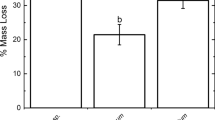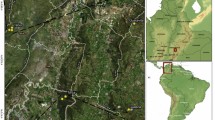Abstract
Earthworm burrow systems are generally described based on postulated behaviours associated with the three ecological types. In this study, we used X-ray tomography to obtain 3D information on the burrowing behaviour of six very common anecic (Aporrectodea nocturna and Lumbricus terrestris) and endogeic (Aporrectodea rosea, Allolobophora chlorotica, Aporrectodea caliginosa, Aporrectodea icterica) earthworm species, introduced into repacked soil cores for 6 weeks. A simple water infiltration test, the Beerkan method, was also used to assess some functional properties of these burrow systems. Endogeic worms make larger burrow systems, which are more highly branched, less continuous and of smaller diameter, than those of anecic worms. Among the anecic species, L. terrestris burrow systems are shorter (9.2 vs 21.2 m) with a higher number (14.5 vs 23.5) of less branched burrows (12.2 vs 20.2 branches m−1), which are also wider (7.78 vs 5.16 mm) than those of A. nocturna. In comparison, the burrow systems made by endogeic species appeared similar to each other. However, A. rosea burrows were short and narrow, whereas A. icterica had a longer burrow system (15.7 m), more intense bioturbation intensity (refilled macropores or soil lateral compaction around them) and thus a greater number of burrows. Regarding water infiltration, anecic burrow systems were far more efficient due to open burrows linking the top and bottom of the cores. For endogeic species, we observed a linear relationship between burrow length and the water infiltration rate (R 2 = 0.49, p < 0.01). Overall, the three main characteristics significantly influencing water infiltration were burrow length, burrow number and bioturbation volume. This last characteristic highlighted the effect of burrow refilling by casts.





Similar content being viewed by others
References
Allaire-Leung SE, Gupta SC, Moncrief JF (2000) Water and solute movement in soil as affected by macropore characteristics.1. Macropore continuity. J Contam Hydrol 41:283–301
Auclerc A, Capowiez Y, Guérold F, Nahmani J (2013) Application of X-ray tomography to evaluate liming impact on earthworm burrowing activity in an acidic forest soil under laboratory conditions. Geoderma 202–203:45–50
Badorreck A, Gerke HH, Huttl RF (2012) Effects of ground-dwelling beetle burrows on infiltration patterns and pore structure of initial soil surfaces. Vad Zone J 11, 10.2136/vzj2011.0109
Bastardie F, Cannavacciuollo M, Capowiez Y, Dreuzy J-R, Bellido A, Cluzeau D (2002) A new simulation for modelling the topology of earthworm burrow systems and their effects on macropore flow in experimental soils. Biol Fertil Soils 36:161–169
Bastardie F, Capowiez Y, Renault P, Cluzeau D (2005a) A radio-labelled study of earthworm behaviour in artificial soil cores in term of ecological types. Biol Fertil Soils 41:320–327
Bastardie F, Ruy S, Cluzeau D (2005b) Assessment of earthworm contribution to soil hydrology: a laboratory method to measure water diffusion through burrow walls. Biol Fertil Soils 41:124–128
Bottinelli N, Jouquet P, Capowiez Y, Podwojewski P, Grimaldi M, Peng X (2015) Why is the influence of soil macrofauna on soil structure only considered by soil ecologists? Soil Till Res 146:118–124
Bouché MB (1972) Lombriciens de France. Ecologie et systématique, INRA, Paris
Braud I, De Condappa D, Soria JM, Haverkamp R, Angulo-Jaramillo R, Galle S, Vauclin M (2005) Use of scaled forms of the infiltration equation for the estimation of unsaturated soil hydraumic properties (the Beerkan method). Eur J Soil Sci 56:361–374
Capowiez Y, Pierret A, Daniel O, Monestiez P, Kretzschmar A (1998) 3D skeleton reconstructions of natural earthworm burrow systems using CAT scan images of soil cores. Biol Fertil Soils 27:51–59
Capowiez Y, Pierret A, Moran CJ (2003) Characterisation of the three-dimensional structure of earthworm burrow systems using image analysis and mathematical morphology. Biol Fertil Soils 38:301–310
Capowiez Y, Bastardie F, Costagliola G (2006) Sublethal effects of imidacloprid on the burrowing behaviour of two earthworm species: modifications of the 3D burrow systems in artificial soil cores and consequences on gas diffusion in soil. Soil Biol Biochem 38:285–293
Capowiez Y, Cadoux S, Bouchand P, Ruy S, Roger-Estrade J, Richard G, Boizard H (2009) The influence of tillage type and compaction on earthworm communities and the consequences for macroporosity and water infiltration in crop fields. Soil Tillage Res 105:209–216
Capowiez Y, Sammartino S, Michel E (2011) Using X-ray tomography to quantify earthworm bioturbation non-destructively in repacked soil cores. Geoderma 162:124–131
Capowiez Y, Sammartino S, Michel E (2014) Burrow systems of endogeic earthworms: effects of earthworm abundance and consequences for soil water infiltration. Pedobiologia 57:303–309
Darwin CR (1881) The formation of vegetable mould through the action of worms, with observations on their habits. Murray, London
Dittbrenner N, Moser I, Triebskorn R, Capowiez Y (2011) Assessment of short and long-term effects of imidacloprid on the burrowing behaviour of two earthworm species (Aporrectodea caliginosa and Lumbricus terrestris) by using 2D and 3D post-exposure techniques. Chemosphere 84:1349–1355
Ernst G, Emmerling C (2009) Impact of ecologically different earthworm species on soil water characteristics. Eur J Soil Biol 45:207–213
Felten D, Emmerling C (2009) Earthworm burrowing behaviour in 2D terraria with single- and multiple-species assemblages. Biol Fertil Soils 45:789–797
Francis GS, Tabley FJ, Butler RC, Fraser PM (2001) The burrowing behaviour of three common earthworm species. Aust J Soil Res 39:1453–1465
Gerino M, Stora G, Francois-Carcaillet F, Gilbert F, Poggiale JC et al (2003) Macro-invertebrate functional groups in freshwater and marine sediments: A common mechanistic classification. Vie et Milieu Life Environ 53:221–231
Jégou D, Cluzeau D, Wolf HJ, Gandon Y, Tréhen P (1998) Assessment of the burrow system of Lumbricus terrestris, Aporrectodea giardi and Aporrectodea caliginosa using X-ray computed tomography. Biol Fertil Soils 26:116–121
Joschko M, Muller PC, Kotzke K, Dohring W, Larink O (1993) Earthworm burrow system-development assessed by means of X-ray computed tomography. Geoderma 56:209–221
Jouquet P, Blanchart E, Capowiez Y (2014) Utilization of earthworms and termites for the restoration of ecosystem functioning. Appl Soil Ecol 73:34–40
Langmaack M, Schrader S, Rapp-Bernhardt U, Kotzke K (1999) Quantitative analysis of earthworm burrow systems with respect to biological soil-structure regeneration after soil compaction. Biol Fertil Soils 28:219–222
Lavelle P (1988) Earthworm activities and the soil system. Biol Fertil Soils 6:237–251
Lavelle P, Spain AV (2001) Soil ecology. Kluwer Academic Publisher, New-York
Lee KE, Foster RC (1991) Soil fauna and soil structure. Austr J Soil Res 29:745–775
Mualem Y, Assouline L, Rohdenburg H (1990) Rainfall induced soil seal. A critical review of observations and models. Catena 17:185–203
Nahmani J, Capowiez Y, Lavelle P (2005) Effects of metal pollution on soil macroinvertebrates burrow systems. Biol Fertil Soils 42:31–39
Needham SJ, Worden RH, McIlroy D (2004) Animal-sediment interactions: the effect of ingestion and excretion by worms on mineralogy. Biogeosciences 1:113–121
Ritz K, Young I (2011) The architecture and biology of soils—life in inner space. CABI, Oxfordshire
Rogasik H, Schrader S, Onasch I, Kiesel J, Gerke HH (2014) Micro-scale dry bulk density variation around earthworm (Lumbricus terrestris L.) burrows based on X-ray computed tomography. Geoderma 213:471–477
Russ JC (1995) The image processing handbook. CRC Press, Boca Raton
Sammartino S, Michel E, Capowiez Y (2012) A novel method to characterize preferential flow in undisturbed soil cores by using multislice helicoïdal CT. Vad Zone J 11. doi 10.2136/vzj2011.0100
Schneider AK, Schröder B (2012) Perspectives in modelling earthworm dynamics and their feedback with abiotic soil properties. Appl Soil Ecol 58:29–36
Shipitalo MJ, Butt KR (1999) Occupancy and geometrical properties of Lumbricus terrestris L. burrows affecting infiltration. Pedobiologia 43:782–794
Shipitalo MJ, Le Bayon RC (2004) Quantifying the effects of earthworms on soil agregation and porosity. In: Edwards CA (ed) Earthworm ecology, 2nd edn. St. Lucie Press, Boca Raton, Fl, pp 183–200
Trojan MD, Linden DR (1992) Microrelief and rainfall effects on water and solute movement in earthworm burrows. Soil Sci Soc Am J 56:727–733
Author information
Authors and Affiliations
Corresponding author
Rights and permissions
About this article
Cite this article
Capowiez, Y., Bottinelli, N., Sammartino, S. et al. Morphological and functional characterisation of the burrow systems of six earthworm species (Lumbricidae). Biol Fertil Soils 51, 869–877 (2015). https://doi.org/10.1007/s00374-015-1036-x
Received:
Revised:
Accepted:
Published:
Issue Date:
DOI: https://doi.org/10.1007/s00374-015-1036-x




